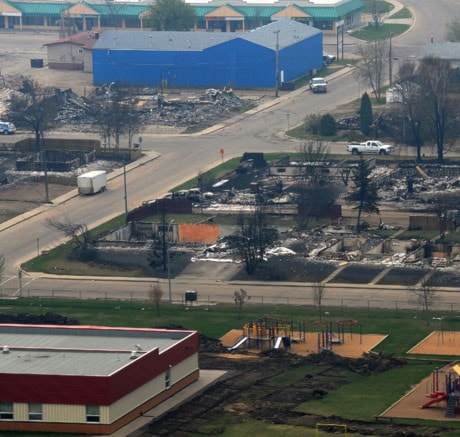EDMONTON — The Alberta government says an unknown arsonist recklessly or deliberately ignited a raging forest fire that wiped out a third of the town of Slave Lake and left 2,000 people homeless.
Frank Oberle, minister of sustainable resources, said Tuesday that the file has been turned over to the RCMP.
“It’s extremely disappointing and my heart goes out to the people that lost homes or property,” Oberle told a news conference.
“This further exacerbates that.”
He said his investigators have determined it was arson because they’ve ruled out all other possible causes for the blaze, which took out 400 homes and businesses on May 15. He wouldn’t say how they’ve definitively ruled out the fire was not set accidentally, such as by a careless camper failing to properly extinguish a fire.
“Our investigation eliminated all natural, industrial or accidental causes.”
Oberle said investigators have determined where the fire started, but he wouldn’t give the co-ordinates because the scene is now part of a criminal investigation. He also wouldn’t describe the area — whether it was near a campsite or deep in the bush.
“We know there was no lightning at that site, no power line malfunction and no campfire located at that site, so a process of elimination gets us to the only reasonable conclusion.”
The minister wouldn’t say if there was forensic evidence found at the scene to suggest arson, but added that a deliberately set forest fire is “relatively rare.” A spokesman for the department later clarified that there is some forensic evidence, but refused to elaborate.
Supt. Marlin Degrand, in charge of criminal investigations for the RCMP in Alberta, said it will be “difficult” to pull together the investigative threads more than five months after the fact.
“After a review we will determine an appropriate course of action,” said Degrand, who sat beside Oberle at the news conference.
Degrand couldn’t say how long the investigation would take.
NDP Leader Brian Mason said while it was disturbing to hear arson may have been the cause, he wondered why it took the province five months to bring in the Mounties.
“As soon as they thought arson might be involved they should have brought in the RCMP,” said Mason. “A parallel investigation would have been more prudent.
“If they wait to bring in the RCMP, someone might get away or slip through their fingers.”
The town of Slave Lake, 250 kilometres northwest of Edmonton, is still struggling to get back on its feet after the devastating fire that was whipped by 100-km/h winds.
Total damage was pegged at $700 million, which insurance adjusters estimate makes it the second-costliest disaster next to the Quebec-Ontario ice storm of 1998, which cost about $1.8 billion.
The fire forced all 7,000 residents to leave for two weeks as fire crews completed salvage work and police secured the area.
No one was hurt, but a fire-fighting helicopter pilot crashed on Lesser Slave Lake and died. There were 1,400 firefighters deployed along with 170 helicopters and tankers.
Images of entire neighbourhoods razed to ash, homes reduced to charred cement foundations, were beamed around the world. In July, Prince William and his wife Kate made an impromptu visit during their cross-Canada tour to show support.
Questions were raised in the aftermath over how the evacuation was carried out. Residents wanted to know why they were not given ample warning to leave. Some who left on their own were forced to turn around when roads were closed.
Days after the fire, the Alberta Emergency Management Agency said it did not recommend an evacuation, then later reversed its position and said it had directed Mayor Karina Pillay-Kinnee to do so.
Pillay-Kinnee said the province ordered the evacuation after 6 p.m. on that fateful day, but by then heavy smoke had closed the roads out of town.
Municipalities are responsible for ordering evacuations but are dependent on information and fire updates from the province.
